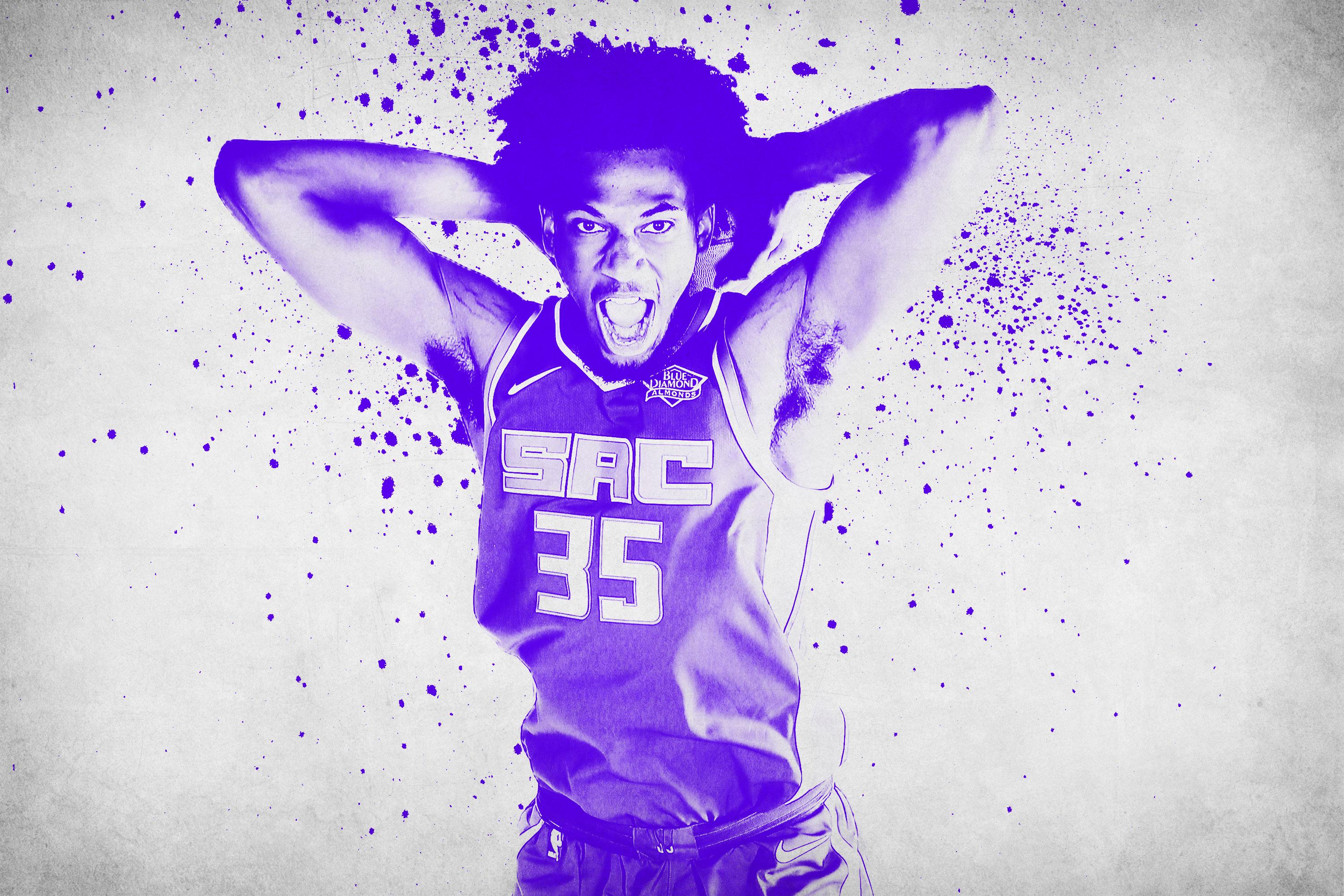
The summer is a time to dream big with newly drafted rookies. But paths to stardom in the NBA are never linear, and every rookie has a unique set of roadblocks to overcome before they can capitalize on their potential. Over the next few weeks, Jonathan Tjarks will be examining some of the 2018 draft’s top talents and how the reality of their team’s situation will affect their freshman season. Welcome to the Rookie Curve.
Marvin Bagley III had a rough NBA debut. The no. 2 overall pick in this year’s draft struggled at summer league, averaging 10.3 points on 33.3 percent shooting and 5.8 rebounds per game. It was nothing like his freshman season at Duke, when he was the most dominant player in the country. Bagley was bigger and faster than almost every player he was up against in college. It was hard to see the holes in his game until he faced better competition. The Kings rookie still has the potential to be an elite NBA player, but he’s a long way from reaching it. He’s the biggest boom-or-bust player in the rookie class.
Bagley relies more on brute force than technique. Like a lot of young left-handers, he’s comfortable using only his dominant hand. It didn’t matter in college because he could get to the rim at will and score over defenders without the physical tools to bother his shot. That didn’t work as well over four games against higher-level competition in Sacramento and Las Vegas. Bagley went from the 78th percentile of post scorers in the NCAA to the 14th percentile among players at summer league, according to the tracking numbers at Synergy Sports.
He didn’t have a Plan B when he was stifled inside. While the 19-year-old can play on the perimeter, he’s an inconsistent outside shooter at this stage in his career. His 39.7 shooting percentage from the shorter NCAA 3-point line doesn’t mean much, given his limited number of attempts (1.8 per game). Free throw shooting is the more reliable indicator of how a prospect’s touch will translate, and Bagley shot only 62.7 percent on 6.3 attempts per game. That played out in the small sample size of summer league: He was 1-for-10 from the 3-point line, and he took only one jumper off the dribble.
A consistent 3-point shot would make Bagley a much tougher cover. He has an elite first step for a 6-foot-11 player; few guys his size have the quickness to stay in front of him. He’s also a better ball handler than he showed at Duke. Some of his most impressive plays this summer came when he cleaned the defensive glass and then pushed the ball up the floor himself. If he can force defenders to cover him beyond the 3-point line, he will have more driving lanes to the basket in the half court and open up the floor for his teammates.
But there’s no guarantee that he’ll develop a jumper. It takes most big men years, if it happens at all. DeMarcus Cousins started making 3s in his sixth season in the NBA. Blake Griffin didn’t until his eighth. Josh Smith never did.
While Bagley will have a head start on those guys because big men weren’t expected to shoot 3s when they came into the league, there are players closer to his age who haven’t shown much progress on their jumpers, either. Julius Randle, like Bagley, was a one-and-done lottery pick with a questionable outside shot. Over four NBA seasons, he’s averaged only 0.6 3-point attempts per game.
A poor outside shot is not a death sentence for a big man if he can protect the rim. The hard part about building around players like Bagley and Randle is they can’t do either. Bagley’s defense might be more of a lost cause than his shooting. Duke moved to a 2-3 zone last season partly to protect him. He doesn’t have the length (7-foot wingspan) or instincts to be a good interior defender. He will most likely need to be paired up front with another big man, which makes developing a jumper even more important for him, since few shot-blocking 5s are also good shooters.
Bagley was in the perfect situation in college. He played power forward next to another lottery pick (Wendell Carter Jr.) at center, so he was often matched up with the second-best interior defender. Carter handled most of the defensive responsibilities in their 2-3 zone, and he was skilled enough to play out of the high post and stretch out to the 3-point line, creating room inside for Bagley to operate. The Blue Devils also had elite 3-point shooters spreading the floor in Grayson Allen and Gary Trent Jr., both of whom are now in the NBA. Bagley rarely faced double-teams or played in much traffic at Duke.
His life will be harder in the NBA. Sacramento was 28th in 3-point attempts last season (24 per game). De’Aaron Fox, the no. 5 overall pick in last year’s draft, shot 30.7 percent from 3 on 2.1 attempts per game. The Kings didn’t get much floor-spacing from their big men, either. Kosta Koufos is a traditional center. Zach Randolph is more of an interior scorer. Willie Cauley-Stein and Skal Labissiere are fairly raw offensive players. None of them fit with Bagley as well as Carter did.
The Kings player who most resembles Bagley’s former frontcourt partner is Harry Giles, another Duke product. Giles was one of the most highly touted high school big men in recent years, but a series of knee injuries dropped him all the way to the no. 20 overall pick in last year’s draft. After taking a medical redshirt as a rookie, he showed flashes of his former self at summer league. He outplayed Bagley, averaging 10.1 points on 44 percent shooting and 6.6 rebounds over seven games. Giles isn’t as good an athlete as Bagley after all the injuries, but he’s a more polished offensive player, and he has better defensive instincts.
It’s unclear how Sacramento’s frontcourt rotation will shake out next season. Bagley and Giles need playing time, as does Nemanja Bjelica, a stretch big man the Kings signed this summer to a three-year, $20.5 million contract. Kings GM Vlade Divac suggested that Bagley could play some at the 3, but that would only further compromise the team’s poor floor spacing and perimeter defense. There just doesn’t seem to be much of a plan in Sacramento. The franchise wasted the no. 13 overall pick in the 2016 draft (Georgios Papagiannis) on a center it couldn’t use. The same thing may happen with Cauley-Stein, the no. 6 overall pick in 2015.
The Kings don’t have a first-round pick in 2019 because of a doomed decision to trade it for cap space in 2015. Head coach Dave Joerger will feel pressure to be competitive next season, which will be difficult given the incredible depth in the Western Conference. Sacramento might have the least talented roster of all 15 teams. The team has some interesting young pieces in Fox, Giles, and Bagley, but they are all unfinished products. Player development might not even be Joerger’s top priority next season. Without a draft pick, the franchise has no incentive to tank.
The Kings’ most interesting lineup is their three blue-chip prospects surrounded by two knockdown 3-point shooters (Bogdan Bogdanovic and Buddy Hield) on the wing. While that unit would have trouble stopping anyone, they would at least spread the floor enough to allow Fox and Bagley to attack the rim. The Kings should push the pace and let those two get out in transition as much as possible, where they can take advantage of their athleticism. Sacramento needs its two top-five picks to eventually become good shooters, but it has to work around that issue for the time being.
Bagley, for as dominant as he was in the NCAA, is a fairly risky project. The Kings thought they were playing it safe when they were actually going for broke. Barring a miraculous turnaround, the franchise won’t be a player in free agency anytime soon, and it won’t have another chance at an elite prospect until 2020. Sacramento needs Bagley to become a star. The only way that will happen is if he starts making 3s.

